
Treating Metabolic Acidosis and Slowing the Progression of Chronic Kidney Disease Investor Presentation March 2021 Exhibit 99.1
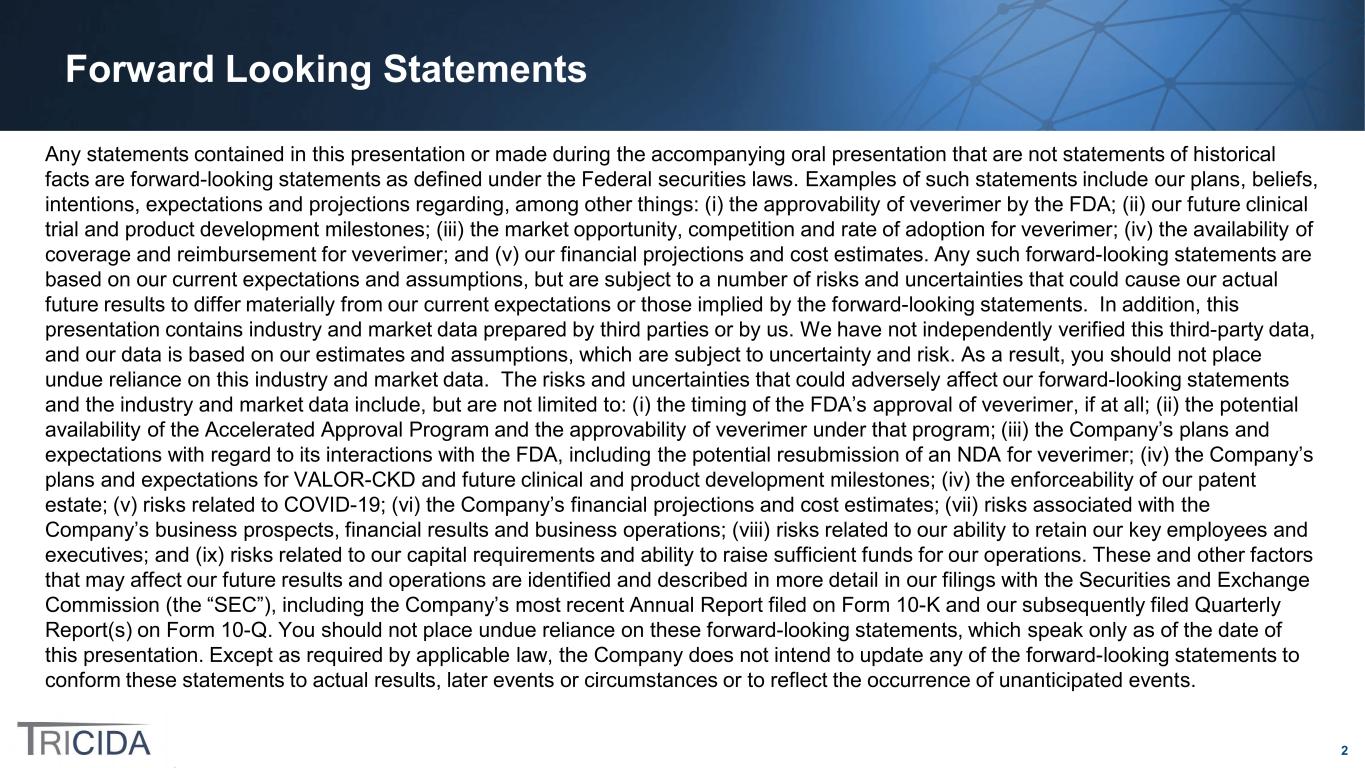
2 Forward Looking Statements Any statements contained in this presentation or made during the accompanying oral presentation that are not statements of historical facts are forward-looking statements as defined under the Federal securities laws. Examples of such statements include our plans, beliefs, intentions, expectations and projections regarding, among other things: (i) the approvability of veverimer by the FDA; (ii) our future clinical trial and product development milestones; (iii) the market opportunity, competition and rate of adoption for veverimer; (iv) the availability of coverage and reimbursement for veverimer; and (v) our financial projections and cost estimates. Any such forward-looking statements are based on our current expectations and assumptions, but are subject to a number of risks and uncertainties that could cause our actual future results to differ materially from our current expectations or those implied by the forward-looking statements. In addition, this presentation contains industry and market data prepared by third parties or by us. We have not independently verified this third-party data, and our data is based on our estimates and assumptions, which are subject to uncertainty and risk. As a result, you should not place undue reliance on this industry and market data. The risks and uncertainties that could adversely affect our forward-looking statements and the industry and market data include, but are not limited to: (i) the timing of the FDA’s approval of veverimer, if at all; (ii) the potential availability of the Accelerated Approval Program and the approvability of veverimer under that program; (iii) the Company’s plans and expectations with regard to its interactions with the FDA, including the potential resubmission of an NDA for veverimer; (iv) the Company’s plans and expectations for VALOR-CKD and future clinical and product development milestones; (iv) the enforceability of our patent estate; (v) risks related to COVID-19; (vi) the Company’s financial projections and cost estimates; (vii) risks associated with the Company’s business prospects, financial results and business operations; (viii) risks related to our ability to retain our key employees and executives; and (ix) risks related to our capital requirements and ability to raise sufficient funds for our operations. These and other factors that may affect our future results and operations are identified and described in more detail in our filings with the Securities and Exchange Commission (the “SEC”), including the Company’s most recent Annual Report filed on Form 10-K and our subsequently filed Quarterly Report(s) on Form 10-Q. You should not place undue reliance on these forward-looking statements, which speak only as of the date of this presentation. Except as required by applicable law, the Company does not intend to update any of the forward-looking statements to conform these statements to actual results, later events or circumstances or to reflect the occurrence of unanticipated events.
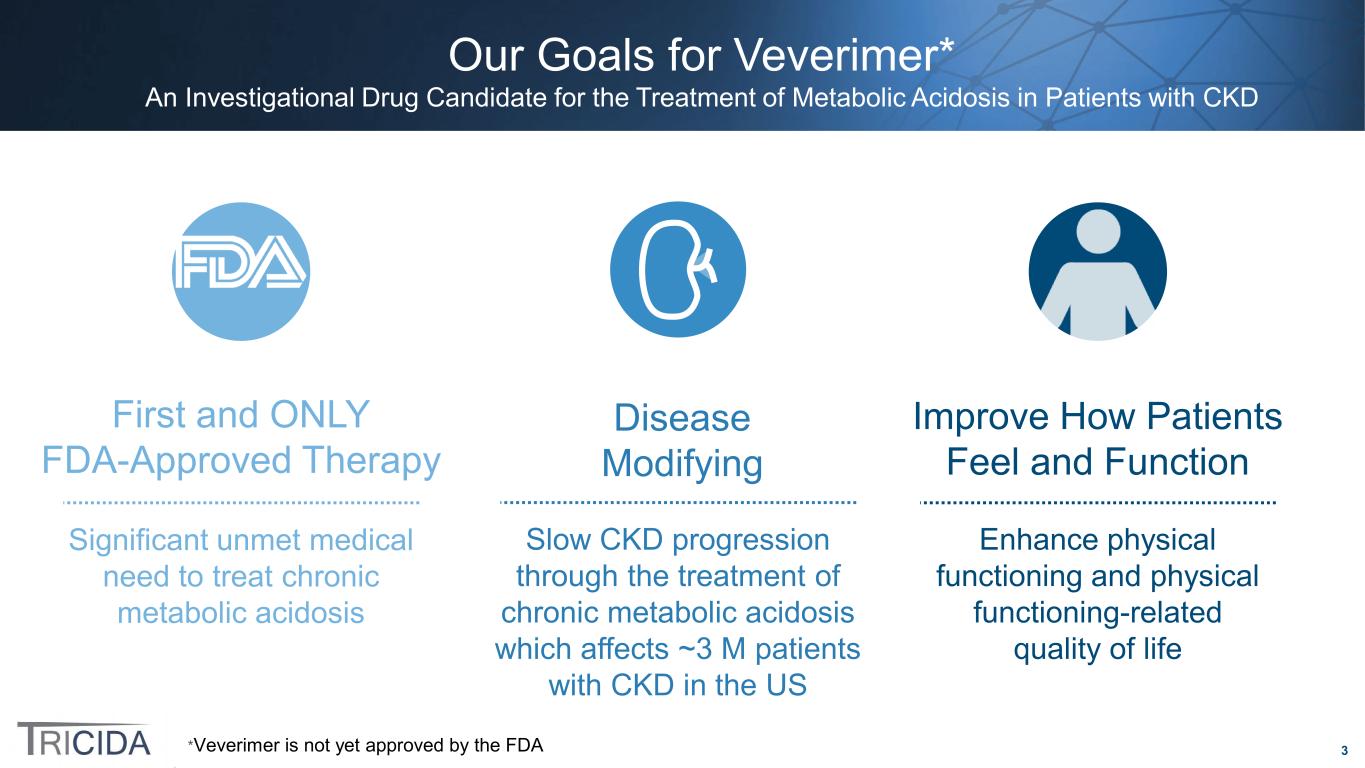
3*Veverimer is not yet approved by the FDA First and ONLY FDA-Approved Therapy Significant unmet medical need to treat chronic metabolic acidosis Improve How Patients Feel and Function Enhance physical functioning and physical functioning-related quality of life Disease Modifying Slow CKD progression through the treatment of chronic metabolic acidosis which affects ~3 M patients with CKD in the US Our Goals for Veverimer* An Investigational Drug Candidate for the Treatment of Metabolic Acidosis in Patients with CKD
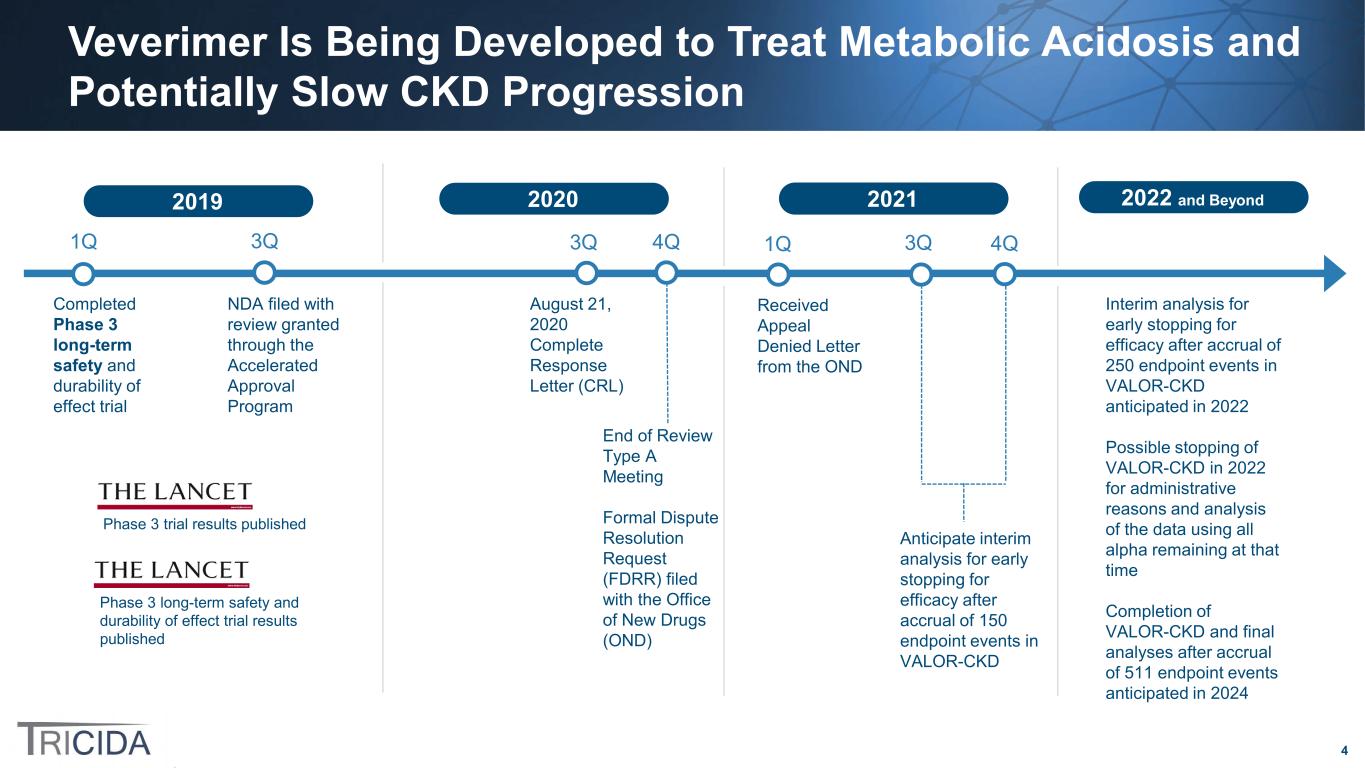
4 Veverimer Is Being Developed to Treat Metabolic Acidosis and Potentially Slow CKD Progression Completed Phase 3 long-term safety and durability of effect trial Phase 3 trial results published Phase 3 long-term safety and durability of effect trial results published NDA filed with review granted through the Accelerated Approval Program 2019 1Q 3Q August 21, 2020 Complete Response Letter (CRL) 2020 4Q End of Review Type A Meeting Formal Dispute Resolution Request (FDRR) filed with the Office of New Drugs (OND) 3Q 2021 Anticipate interim analysis for early stopping for efficacy after accrual of 150 endpoint events in VALOR-CKD 3Q 4Q Received Appeal Denied Letter from the OND 1Q Interim analysis for early stopping for efficacy after accrual of 250 endpoint events in VALOR-CKD anticipated in 2022 Possible stopping of VALOR-CKD in 2022 for administrative reasons and analysis of the data using all alpha remaining at that time Completion of VALOR-CKD and final analyses after accrual of 511 endpoint events anticipated in 2024 2022 and Beyond
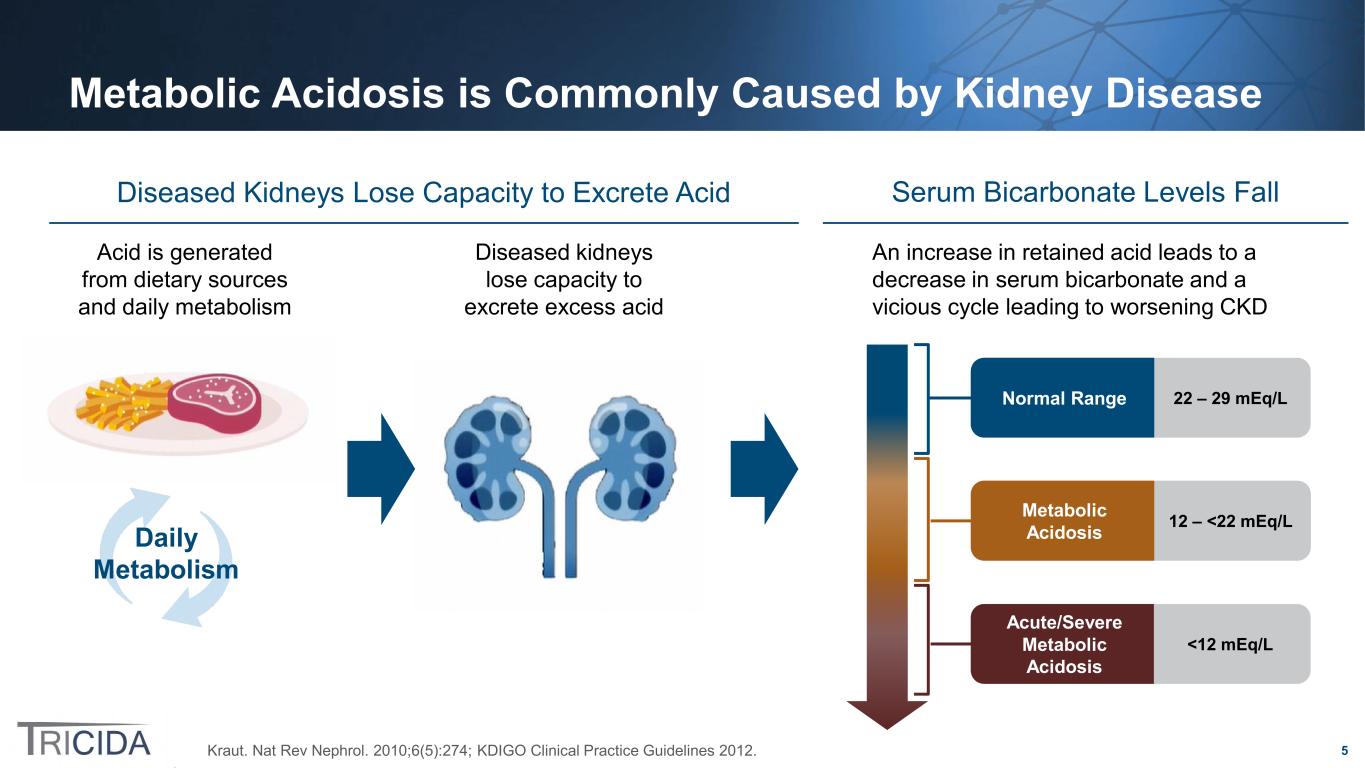
5 Daily Metabolism Metabolic Acidosis is Commonly Caused by Kidney Disease Kraut. Nat Rev Nephrol. 2010;6(5):274; KDIGO Clinical Practice Guidelines 2012. Serum Bicarbonate Levels FallDiseased Kidneys Lose Capacity to Excrete Acid Acid is generated from dietary sources and daily metabolism Diseased kidneys lose capacity to excrete excess acid An increase in retained acid leads to a decrease in serum bicarbonate and a vicious cycle leading to worsening CKD Normal Range Acute/Severe Metabolic Acidosis <12 mEq/L Metabolic Acidosis 12 – <22 mEq/L 22 – 29 mEq/L

6 Metabolic Acidosis Is a Serious Condition Harmful Needs to Be Treated 0% 20% 40% 60% 80% 100% Dobre 2013 Tangri 2020 TRCA-301 Tangri 2019 < 3% < 10% 15% < 6% % o f P at ie nt s R ec ei vi ng O ra l A lk al i T he ra pyThe Majority of Patients with Metabolic Acidosis are NOT treated No FDA Approved Treatments 3,000,000 Patients with CKD are afflicted with Metabolic AcidosisCommon Accelerates CKD Progression Impacts Bone and Muscle Health
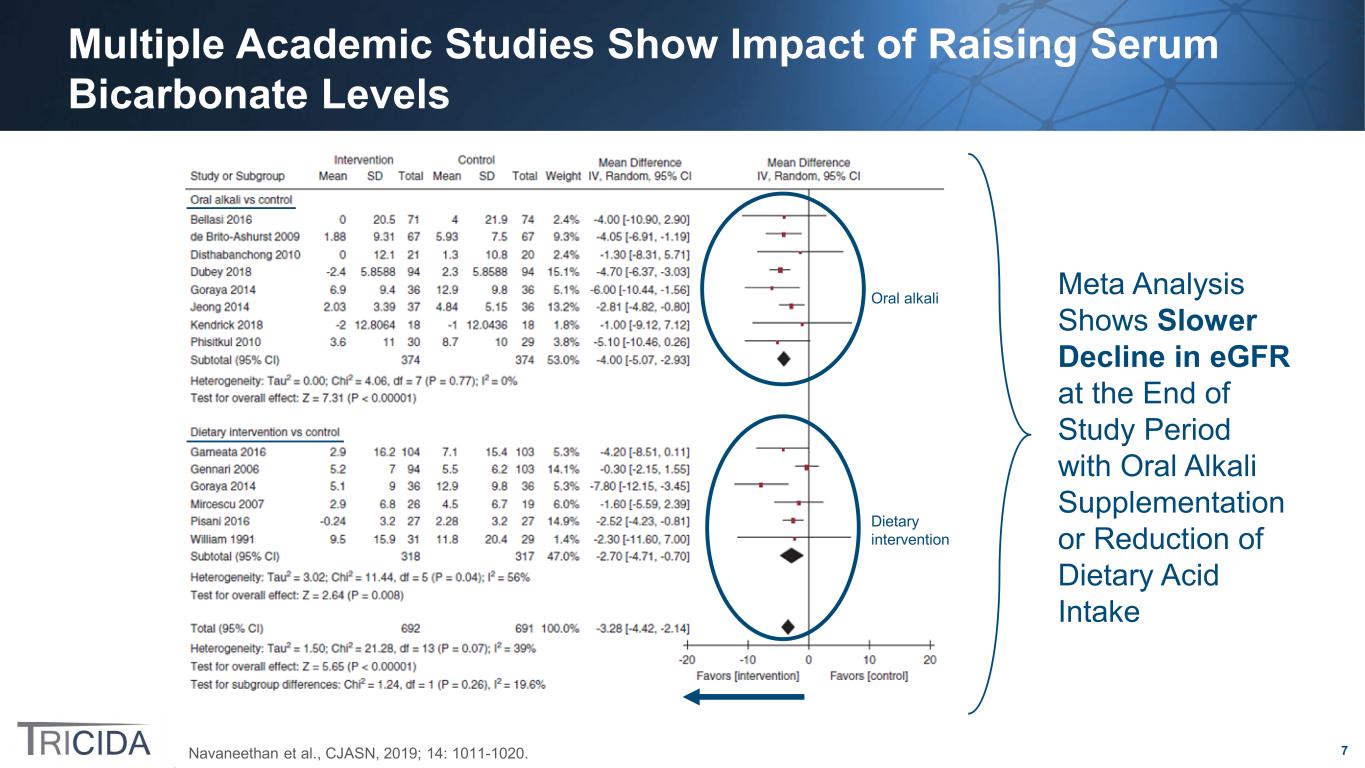
7 Oral alkali Dietary intervention Multiple Academic Studies Show Impact of Raising Serum Bicarbonate Levels Navaneethan et al., CJASN, 2019; 14: 1011-1020. Meta Analysis Shows Slower Decline in eGFR at the End of Study Period with Oral Alkali Supplementation or Reduction of Dietary Acid Intake
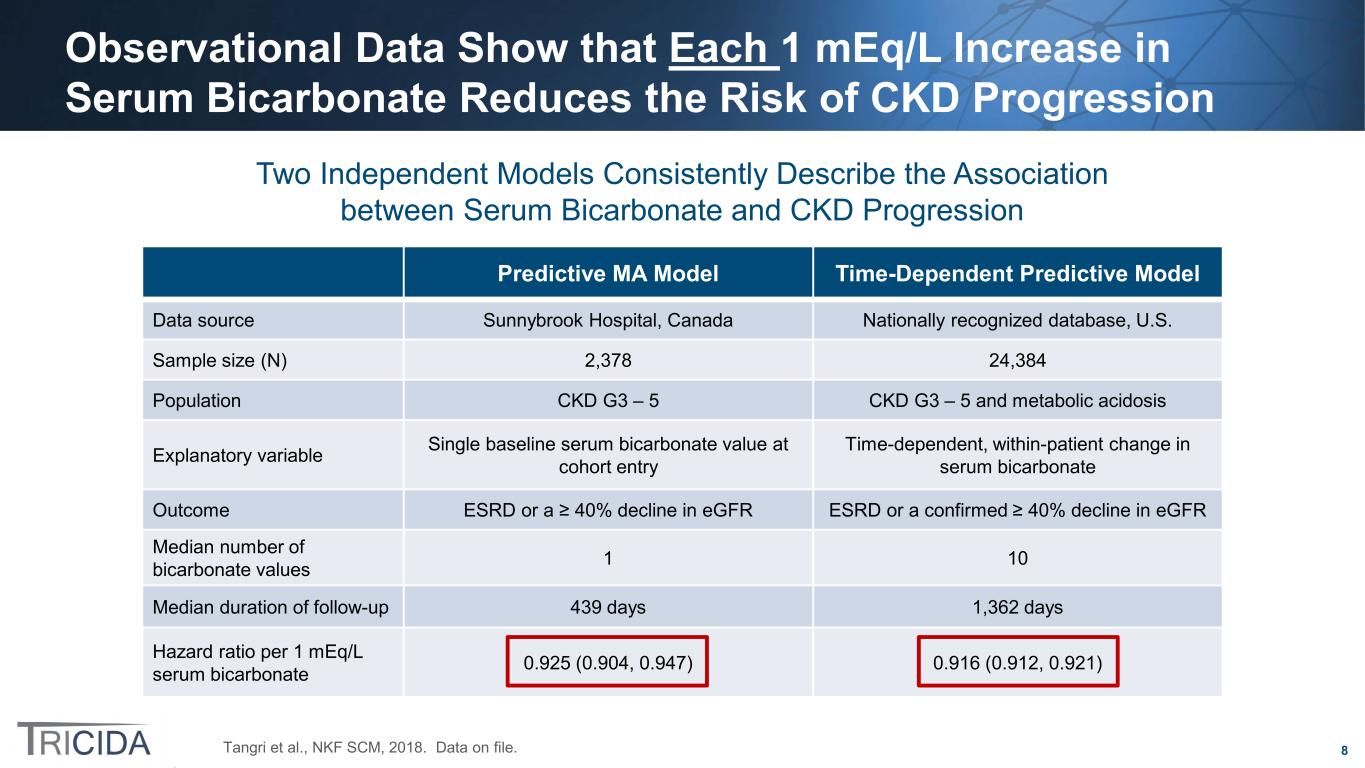
8 Observational Data Show that Each 1 mEq/L Increase in Serum Bicarbonate Reduces the Risk of CKD Progression Tangri et al., NKF SCM, 2018. Data on file. Predictive MA Model Time-Dependent Predictive Model Data source Sunnybrook Hospital, Canada Nationally recognized database, U.S. Sample size (N) 2,378 24,384 Population CKD G3 – 5 CKD G3 – 5 and metabolic acidosis Explanatory variable Single baseline serum bicarbonate value at cohort entry Time-dependent, within-patient change in serum bicarbonate Outcome ESRD or a ≥ 40% decline in eGFR ESRD or a confirmed ≥ 40% decline in eGFR Median number of bicarbonate values 1 10 Median duration of follow-up 439 days 1,362 days Hazard ratio per 1 mEq/L serum bicarbonate 0.925 (0.904, 0.947) 0.916 (0.912, 0.921) Two Independent Models Consistently Describe the Association between Serum Bicarbonate and CKD Progression
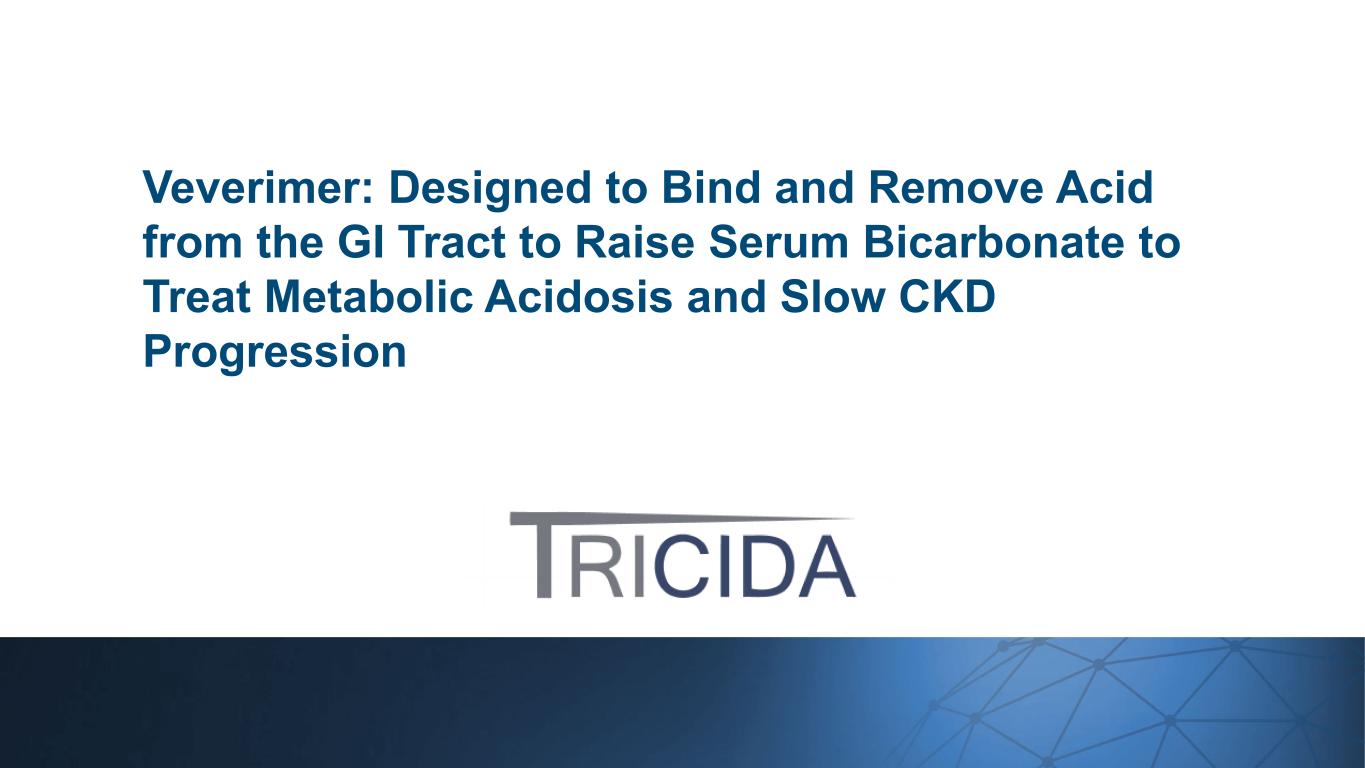
Veverimer: Designed to Bind and Remove Acid from the GI Tract to Raise Serum Bicarbonate to Treat Metabolic Acidosis and Slow CKD Progression
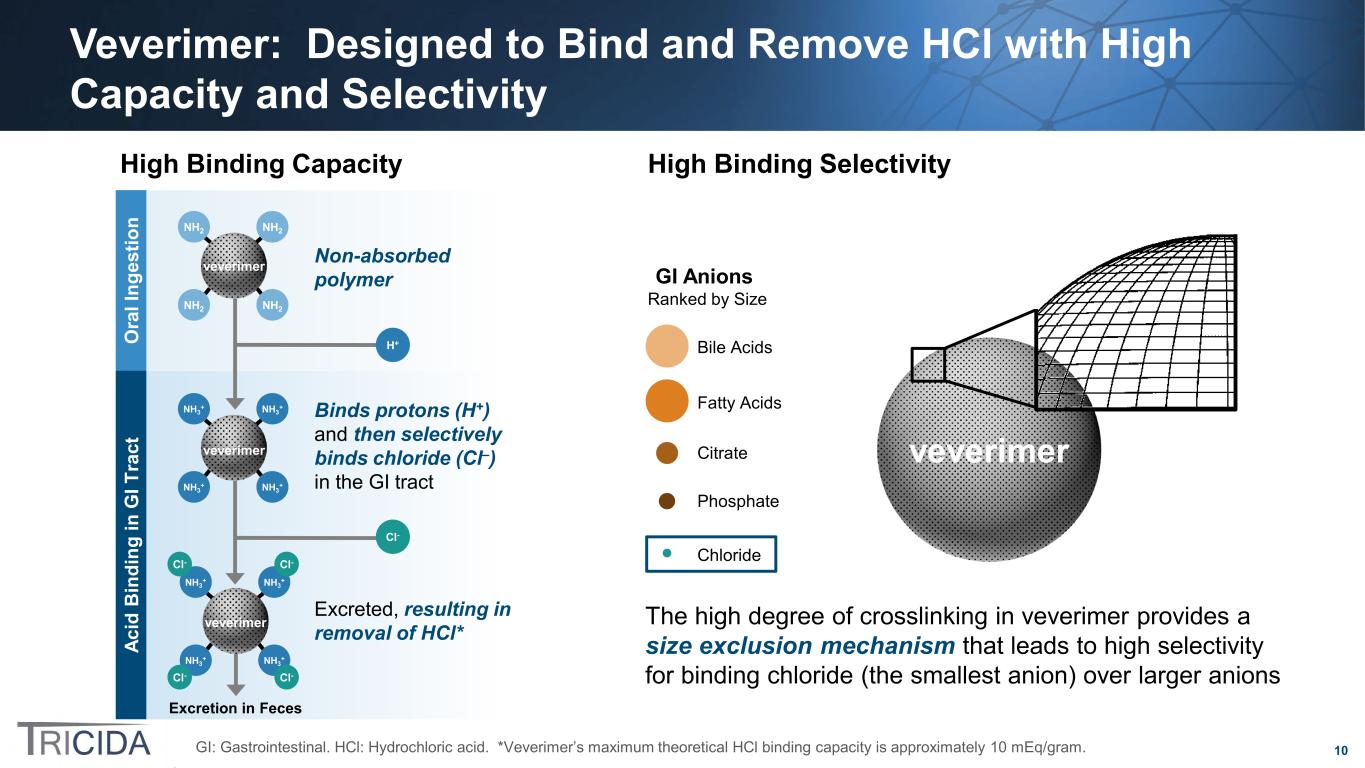
10GI: Gastrointestinal. HCl: Hydrochloric acid. *Veverimer’s maximum theoretical HCl binding capacity is approximately 10 mEq/gram. Excreted, resulting in removal of HCl* Binds protons (H+) and then selectively binds chloride (Cl–) in the GI tract Excretion in Feces O ra l I ng es tio n A ci d B in di ng in G I T ra ct NH2 NH2 NH2 NH2 veverimer NH3+ NH3+ NH3+ NH3+ Cl-Cl- Cl- Cl- veverimer Cl- H+ NH3+ NH3+ NH3+ NH3+ veverimer Non-absorbed polymer veverimerCitrate Chloride Fatty Acids Bile Acids Phosphate GI Anions Ranked by Size The high degree of crosslinking in veverimer provides a size exclusion mechanism that leads to high selectivity for binding chloride (the smallest anion) over larger anions Veverimer: Designed to Bind and Remove HCl with High Capacity and Selectivity High Binding Capacity High Binding Selectivity

11 Veverimer: Ease of Administration* Once-a-day dosing Orally administered as a suspension in water 3 g, 6 g or 9 g dose sizes No observed drug-drug interactions** 2 oz. Water *Targeted profile if approved ** Data on file
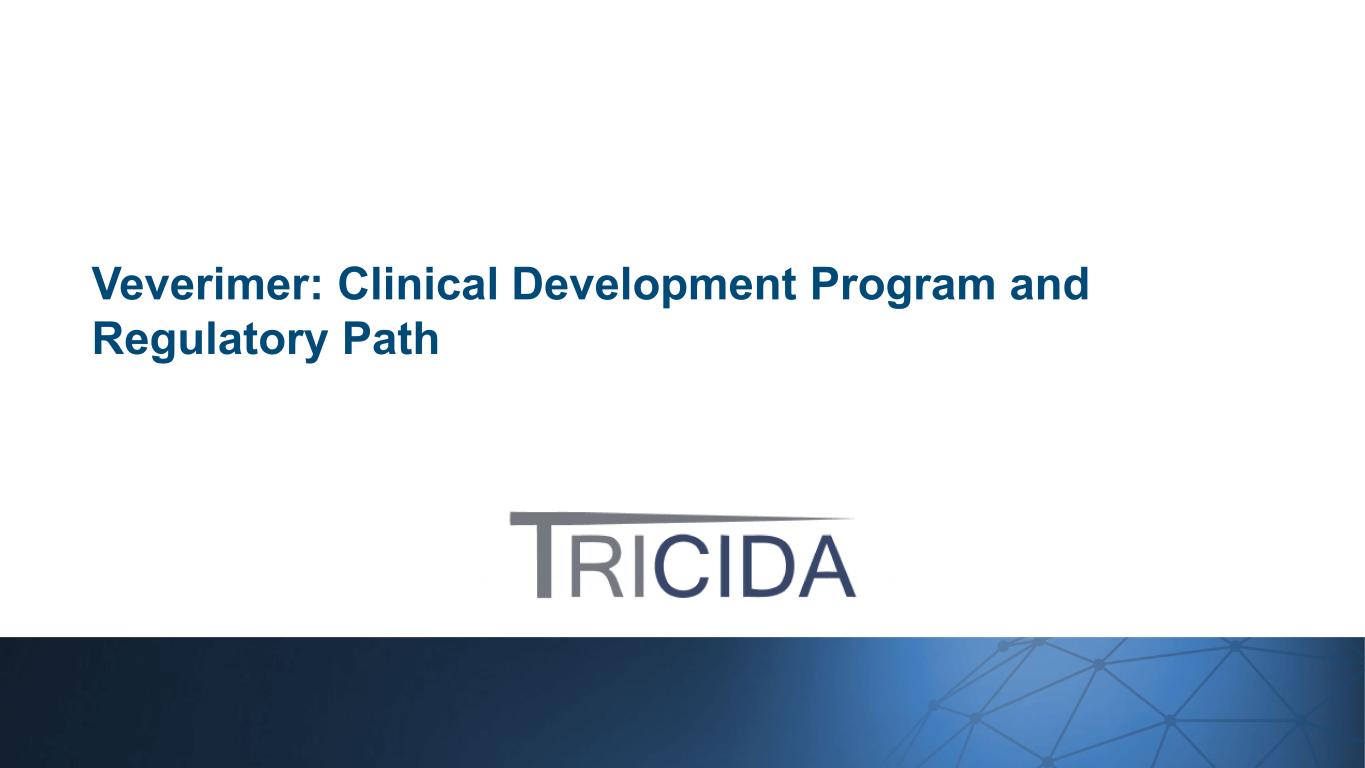
Veverimer: Clinical Development Program and Regulatory Path
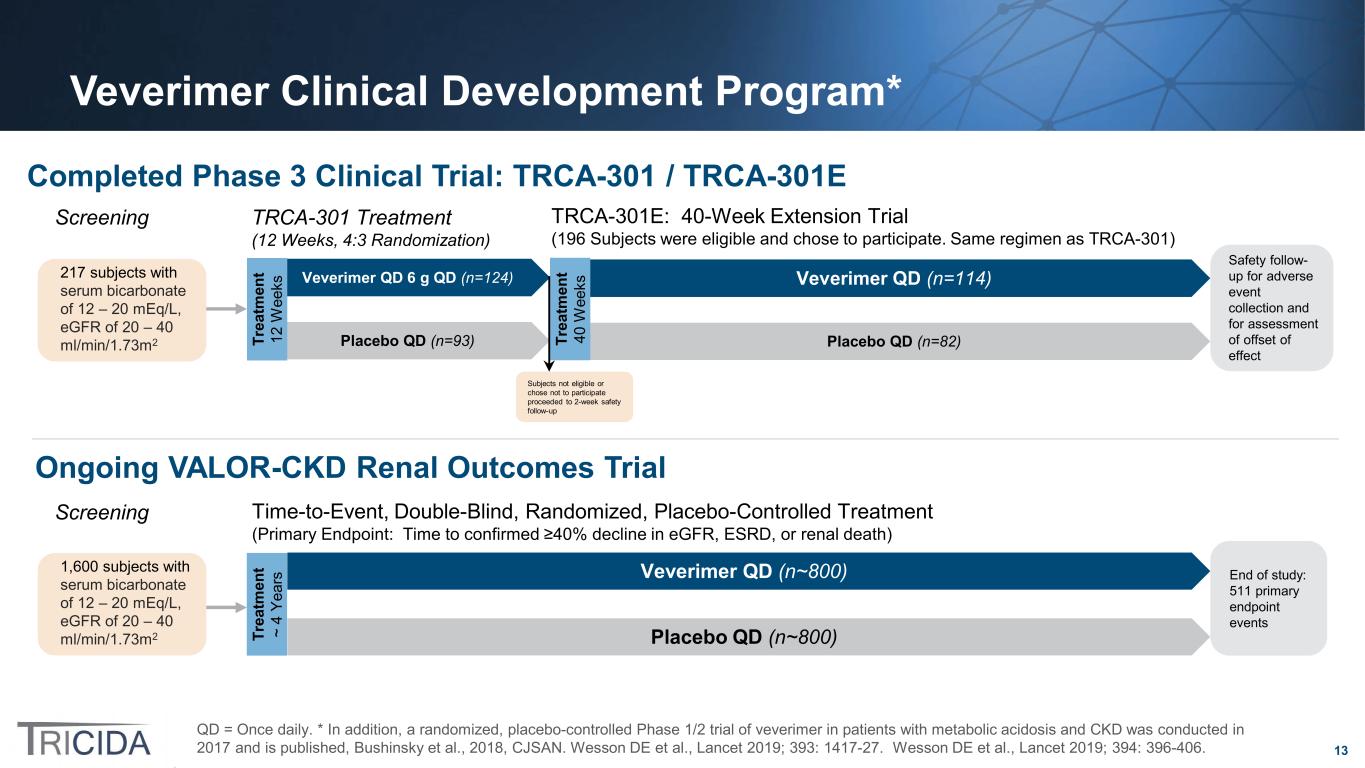
13 Veverimer Clinical Development Program* QD = Once daily. * In addition, a randomized, placebo-controlled Phase 1/2 trial of veverimer in patients with metabolic acidosis and CKD was conducted in 2017 and is published, Bushinsky et al., 2018, CJSAN. Wesson DE et al., Lancet 2019; 393: 1417-27. Wesson DE et al., Lancet 2019; 394: 396-406. Completed Phase 3 Clinical Trial: TRCA-301 / TRCA-301E Ongoing VALOR-CKD Renal Outcomes Trial Veverimer QD (n~800) Placebo QD (n~800)Tr ea tm en t ~ 4 Y ea rs End of study: 511 primary endpoint events 1,600 subjects with serum bicarbonate of 12 – 20 mEq/L, eGFR of 20 – 40 ml/min/1.73m2 Screening Time-to-Event, Double-Blind, Randomized, Placebo-Controlled Treatment (Primary Endpoint: Time to confirmed ≥40% decline in eGFR, ESRD, or renal death) Subjects not eligible or chose not to participate proceeded to 2-week safety follow-up Veverimer QD 6 g QD (n=124) Placebo QD (n=93)Tr ea tm en t 12 W ee ks Veverimer QD (n=114) Placebo QD (n=82)T re at m en t 40 W ee ks TRCA-301 Treatment (12 Weeks, 4:3 Randomization) TRCA-301E: 40-Week Extension Trial (196 Subjects were eligible and chose to participate. Same regimen as TRCA-301) 217 subjects with serum bicarbonate of 12 – 20 mEq/L, eGFR of 20 – 40 ml/min/1.73m2 Screening Safety follow- up for adverse event collection and for assessment of offset of effect
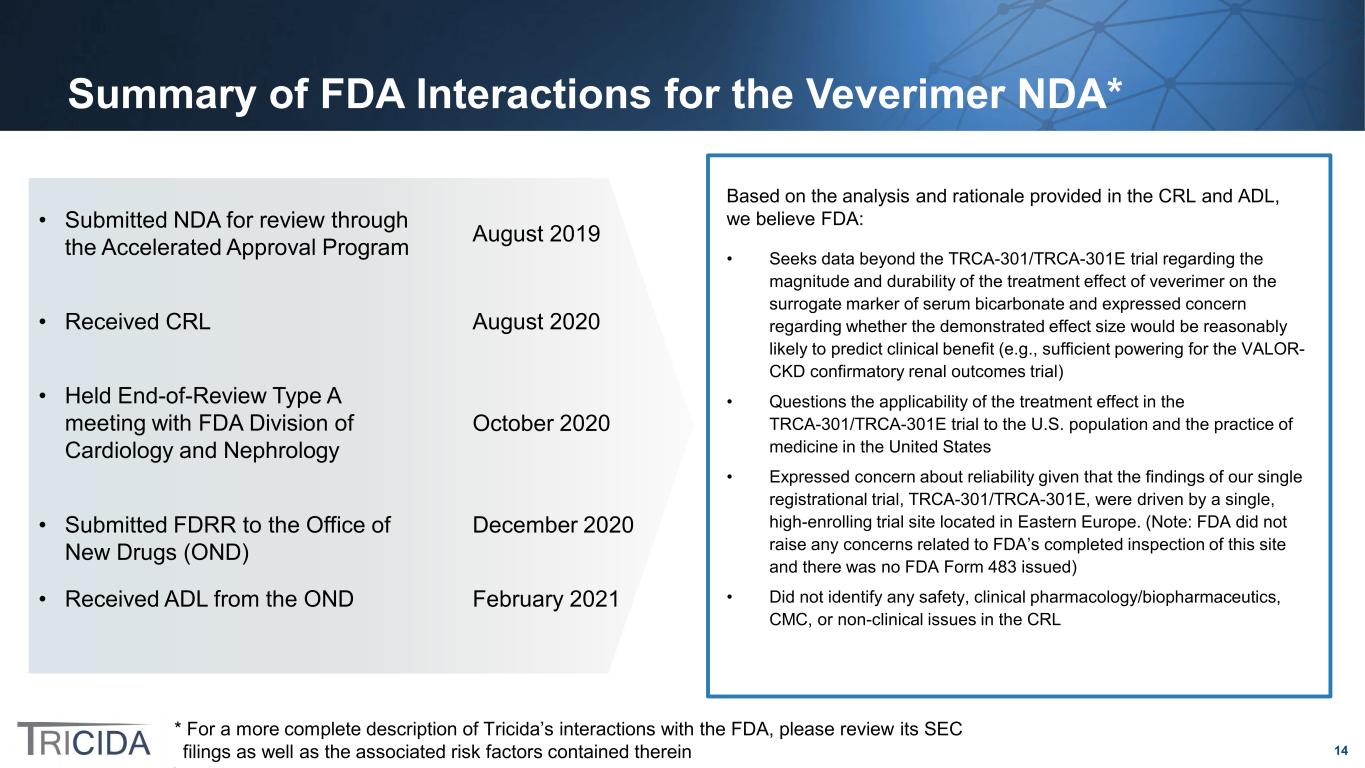
14 Summary of FDA Interactions for the Veverimer NDA* • Submitted NDA for review through the Accelerated Approval Program August 2019 • Received CRL August 2020 • Held End-of-Review Type A meeting with FDA Division of Cardiology and Nephrology October 2020 • Submitted FDRR to the Office of New Drugs (OND) December 2020 • Received ADL from the OND February 2021 Based on the analysis and rationale provided in the CRL and ADL, we believe FDA: • Seeks data beyond the TRCA-301/TRCA-301E trial regarding the magnitude and durability of the treatment effect of veverimer on the surrogate marker of serum bicarbonate and expressed concern regarding whether the demonstrated effect size would be reasonably likely to predict clinical benefit (e.g., sufficient powering for the VALOR- CKD confirmatory renal outcomes trial) • Questions the applicability of the treatment effect in the TRCA-301/TRCA-301E trial to the U.S. population and the practice of medicine in the United States • Expressed concern about reliability given that the findings of our single registrational trial, TRCA-301/TRCA-301E, were driven by a single, high-enrolling trial site located in Eastern Europe. (Note: FDA did not raise any concerns related to FDA’s completed inspection of this site and there was no FDA Form 483 issued) • Did not identify any safety, clinical pharmacology/biopharmaceutics, CMC, or non-clinical issues in the CRL * For a more complete description of Tricida’s interactions with the FDA, please review its SEC filings as well as the associated risk factors contained therein

15 Tricida Believes There Are Several Potential Pathways to Approval of Veverimer • VALOR-CKD stopped early for administrative reasons and yields positive data: – Slowing of CKD progression – Physical functioning Potential Approval Pathway Potential Timing of Data Based on Current Event Accumulation Potential Pathways to Approval of Veverimer* Traditional Approval Prior to the end of 2022 • Results from either interim 1 analysis or interim 2 analysis in VALOR-CKD show a positive effect of veverimer on renal outcomes and Interim Analysis Committee recommends early stopping for efficacy Traditional Approval2H 2021 Interim Analysis 1 Mid-2022 Interim Analysis 2 • In the ADL, OND suggested that we meet with the Division to discuss submission of Week 52 serum bicarbonate results from the full randomized VALOR-CKD trial population Accelerated ApprovalEarly 2023 *In any NDA resubmission the issues raised in the CRL and ADL will likely be review issues subject to the discretion of the FDA. An additional study or studies may be required for approval of veverimer.
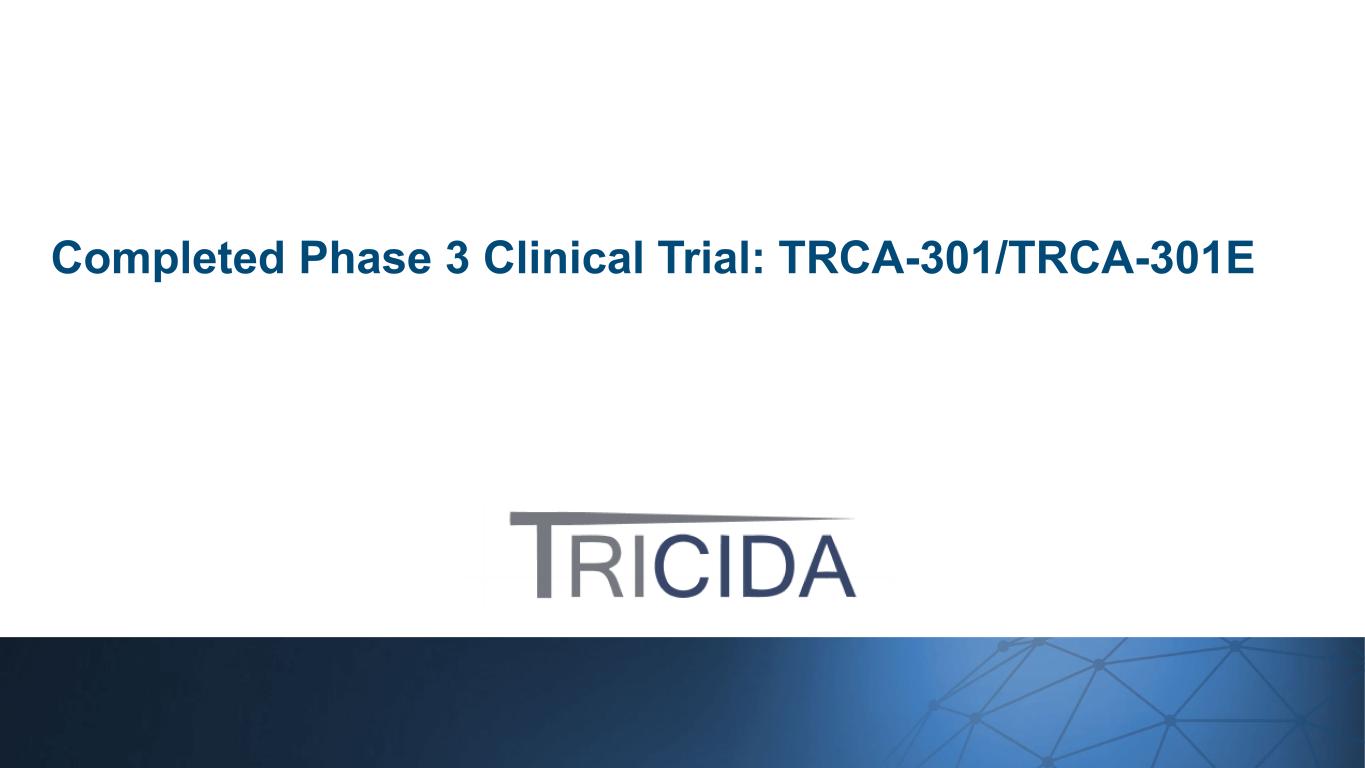
Completed Phase 3 Clinical Trial: TRCA-301/TRCA-301E

17 Veverimer: TRCA-301 and TRCA-301E Trial Results Published in The Lancet TRCA-301 Results TRCA-301E Results Wesson DE et al., Lancet 2019; 393: 1417-27. Wesson DE et al., Lancet 2019; 394: 396-406.
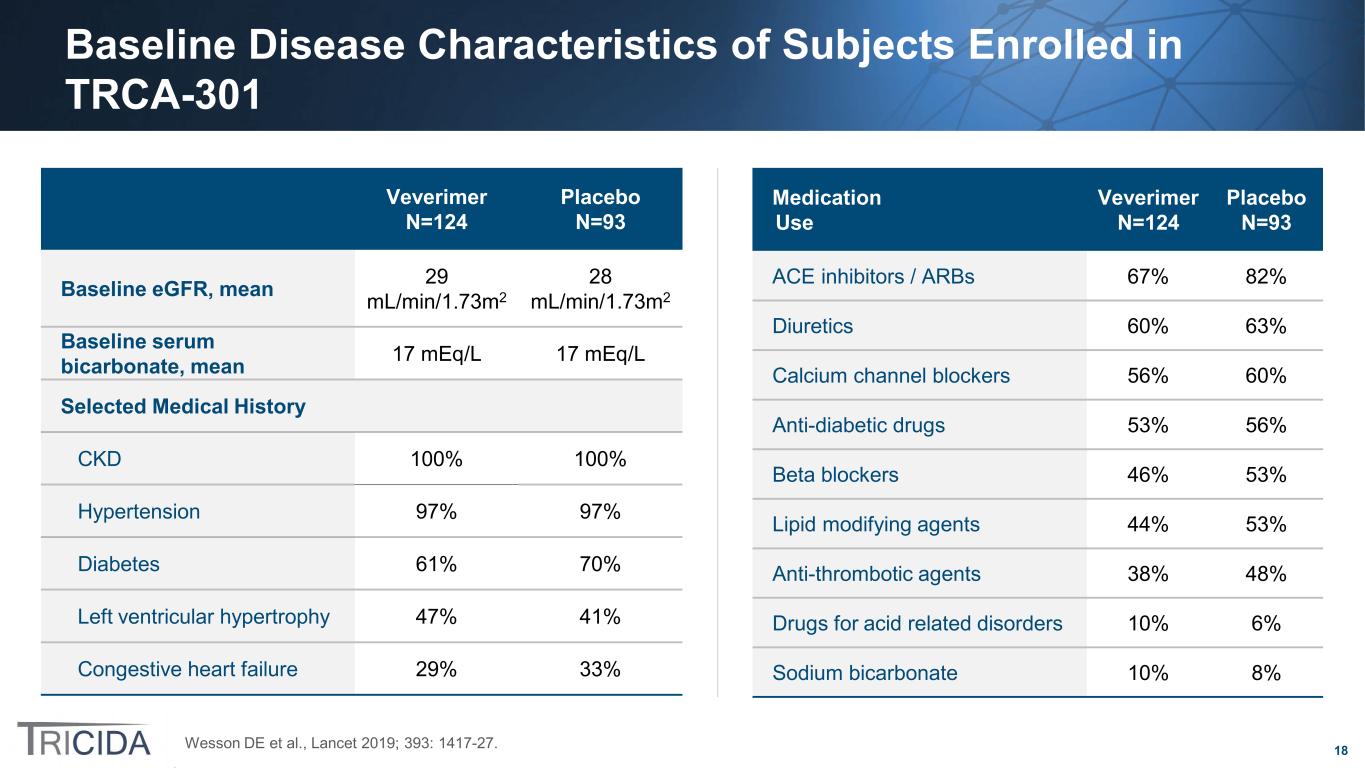
18 Baseline Disease Characteristics of Subjects Enrolled in TRCA-301 Veverimer N=124 Placebo N=93 Baseline eGFR, mean 29 mL/min/1.73m2 28 mL/min/1.73m2 Baseline serum bicarbonate, mean 17 mEq/L 17 mEq/L Selected Medical History CKD 100% 100% Hypertension 97% 97% Diabetes 61% 70% Left ventricular hypertrophy 47% 41% Congestive heart failure 29% 33% Medication Use Veverimer N=124 Placebo N=93 ACE inhibitors / ARBs 67% 82% Diuretics 60% 63% Calcium channel blockers 56% 60% Anti-diabetic drugs 53% 56% Beta blockers 46% 53% Lipid modifying agents 44% 53% Anti-thrombotic agents 38% 48% Drugs for acid related disorders 10% 6% Sodium bicarbonate 10% 8% Wesson DE et al., Lancet 2019; 393: 1417-27.
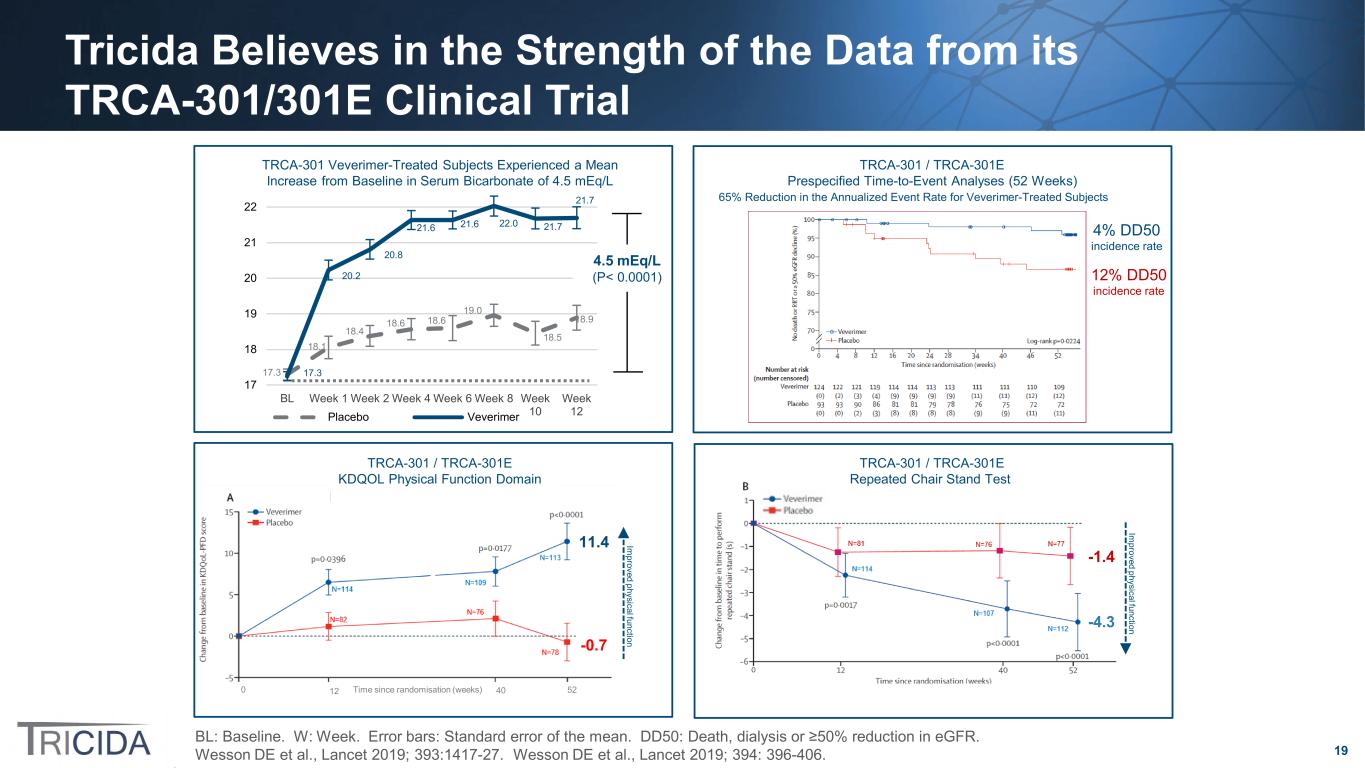
19 TRCA-301 Veverimer-Treated Subjects Experienced a Mean Increase from Baseline in Serum Bicarbonate of 4.5 mEq/L Tricida Believes in the Strength of the Data from its TRCA-301/301E Clinical Trial BL: Baseline. W: Week. Error bars: Standard error of the mean. DD50: Death, dialysis or ≥50% reduction in eGFR. Wesson DE et al., Lancet 2019; 393:1417-27. Wesson DE et al., Lancet 2019; 394: 396-406. 17.3 18.1 18.4 18.6 18.6 19.0 18.5 18.9 17.3 20.2 20.8 21.6 21.6 22.0 21.7 21.7 17 18 19 20 21 22 BL Week 1 Week 2 Week 4 Week 6 Week 8 Week 10 Week 12Placebo Veverimer 4.5 mEq/L (P< 0.0001) TRCA-301 / TRCA-301E Prespecified Time-to-Event Analyses (52 Weeks) 4% DD50 incidence rate 12% DD50 incidence rate 65% Reduction in the Annualized Event Rate for Veverimer-Treated Subjects Time since randomisation (weeks) TRCA-301 / TRCA-301E Repeated Chair Stand Test 00 0 0 12 40 52 -1.4 -4.3 Im proved physical function 11.4 -0.7 Im proved physical function TRCA-301 / TRCA-301E KDQOL Physical Function Domain

20 Veverimer: TRCA-301/301E Safety Summary TRCA-301 TRCA-301E Veverimer (n=124) Placebo (n=93) Veverimer (n=114) Placebo (n=82) Serious adverse events (none assessed to be related to study drug)* 2.4% 2.2% 1.8% 4.9% Discontinued study treatment 4.0% 4.3% 2.6% 9.8% Discontinued study due to an adverse event* 0.8% 2.2% 0 1.2% Treatment-emergent adverse events* 54.0% 46.2% 81.3% 80.2% Gastrointestinal adverse events 16.9% 8.6% 21.4% 25.9% * Safety endpoints for the TRCA-301E 40-week extension trial. Wesson DE et al., Lancet 2019; 393: 1417-27. Wesson DE et al., Lancet 2019; 394: 396-406.

Ongoing VALOR-CKD Renal Outcomes Trial
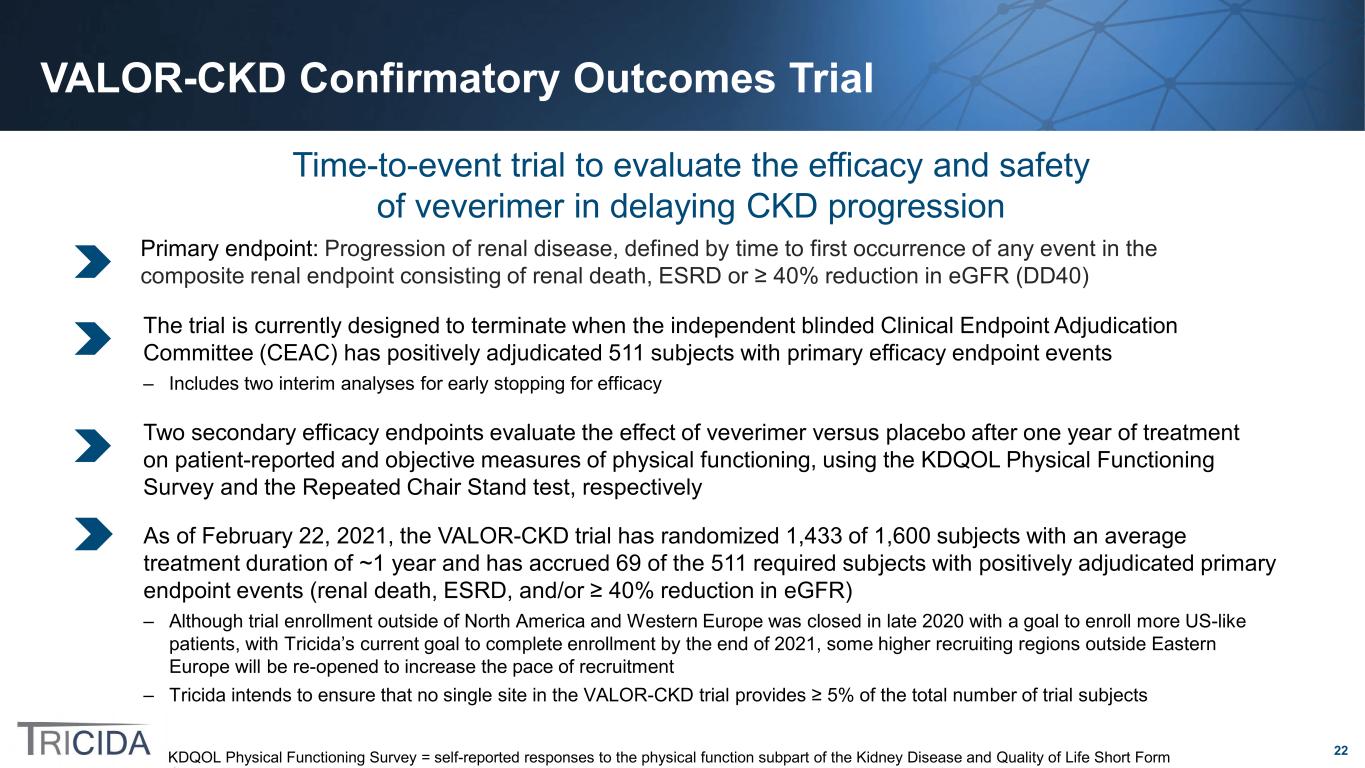
22 VALOR-CKD Confirmatory Outcomes Trial The trial is currently designed to terminate when the independent blinded Clinical Endpoint Adjudication Committee (CEAC) has positively adjudicated 511 subjects with primary efficacy endpoint events – Includes two interim analyses for early stopping for efficacy Time-to-event trial to evaluate the efficacy and safety of veverimer in delaying CKD progression Primary endpoint: Progression of renal disease, defined by time to first occurrence of any event in the composite renal endpoint consisting of renal death, ESRD or ≥ 40% reduction in eGFR (DD40) As of February 22, 2021, the VALOR-CKD trial has randomized 1,433 of 1,600 subjects with an average treatment duration of ~1 year and has accrued 69 of the 511 required subjects with positively adjudicated primary endpoint events (renal death, ESRD, and/or ≥ 40% reduction in eGFR) – Although trial enrollment outside of North America and Western Europe was closed in late 2020 with a goal to enroll more US-like patients, with Tricida’s current goal to complete enrollment by the end of 2021, some higher recruiting regions outside Eastern Europe will be re-opened to increase the pace of recruitment – Tricida intends to ensure that no single site in the VALOR-CKD trial provides ≥ 5% of the total number of trial subjects Two secondary efficacy endpoints evaluate the effect of veverimer versus placebo after one year of treatment on patient-reported and objective measures of physical functioning, using the KDQOL Physical Functioning Survey and the Repeated Chair Stand test, respectively KDQOL Physical Functioning Survey = self-reported responses to the physical function subpart of the Kidney Disease and Quality of Life Short Form
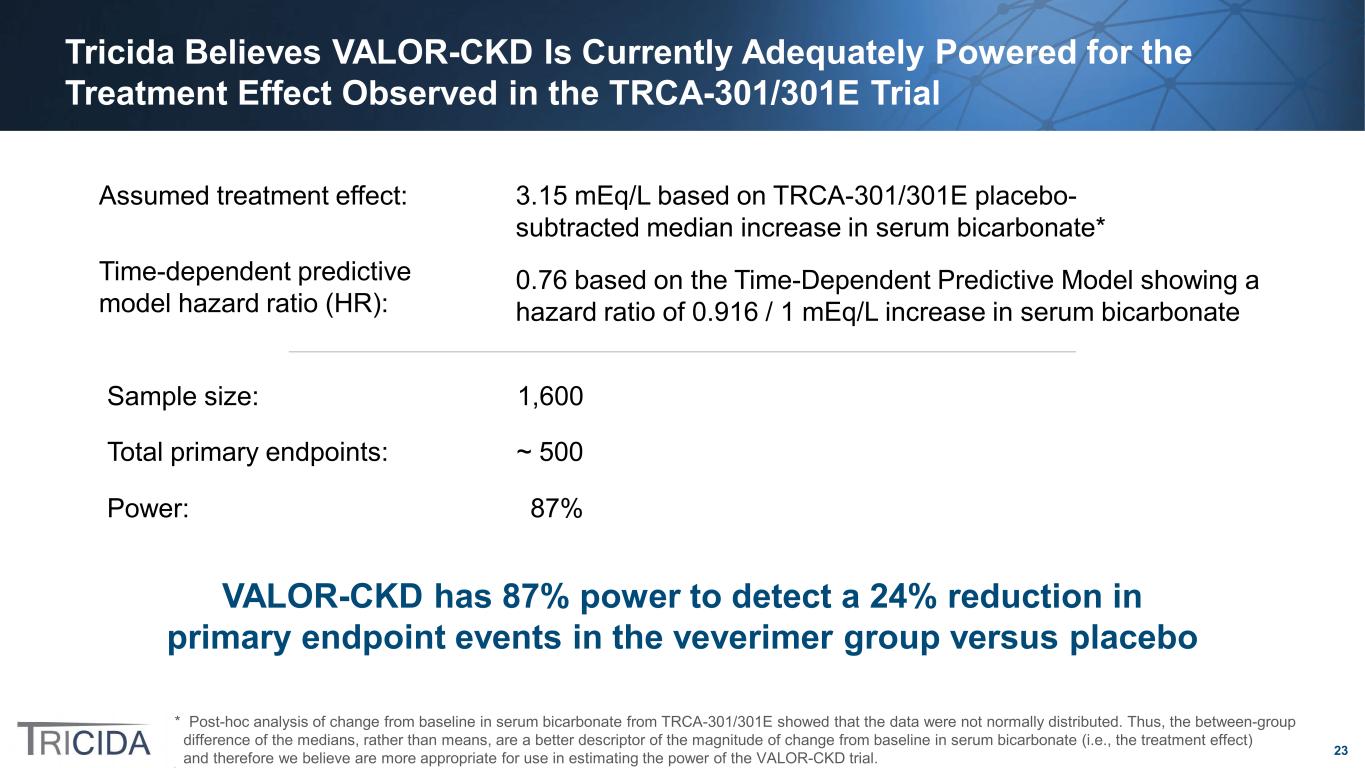
23 Tricida Believes VALOR-CKD Is Currently Adequately Powered for the Treatment Effect Observed in the TRCA-301/301E Trial * Post-hoc analysis of change from baseline in serum bicarbonate from TRCA-301/301E showed that the data were not normally distributed. Thus, the between-group difference of the medians, rather than means, are a better descriptor of the magnitude of change from baseline in serum bicarbonate (i.e., the treatment effect) and therefore we believe are more appropriate for use in estimating the power of the VALOR-CKD trial. Assumed treatment effect: 3.15 mEq/L based on TRCA-301/301E placebo- subtracted median increase in serum bicarbonate* Time-dependent predictive model hazard ratio (HR): 0.76 based on the Time-Dependent Predictive Model showing a hazard ratio of 0.916 / 1 mEq/L increase in serum bicarbonate Sample size: 1,600 Total primary endpoints: ~ 500 Power: 87% VALOR-CKD has 87% power to detect a 24% reduction in primary endpoint events in the veverimer group versus placebo
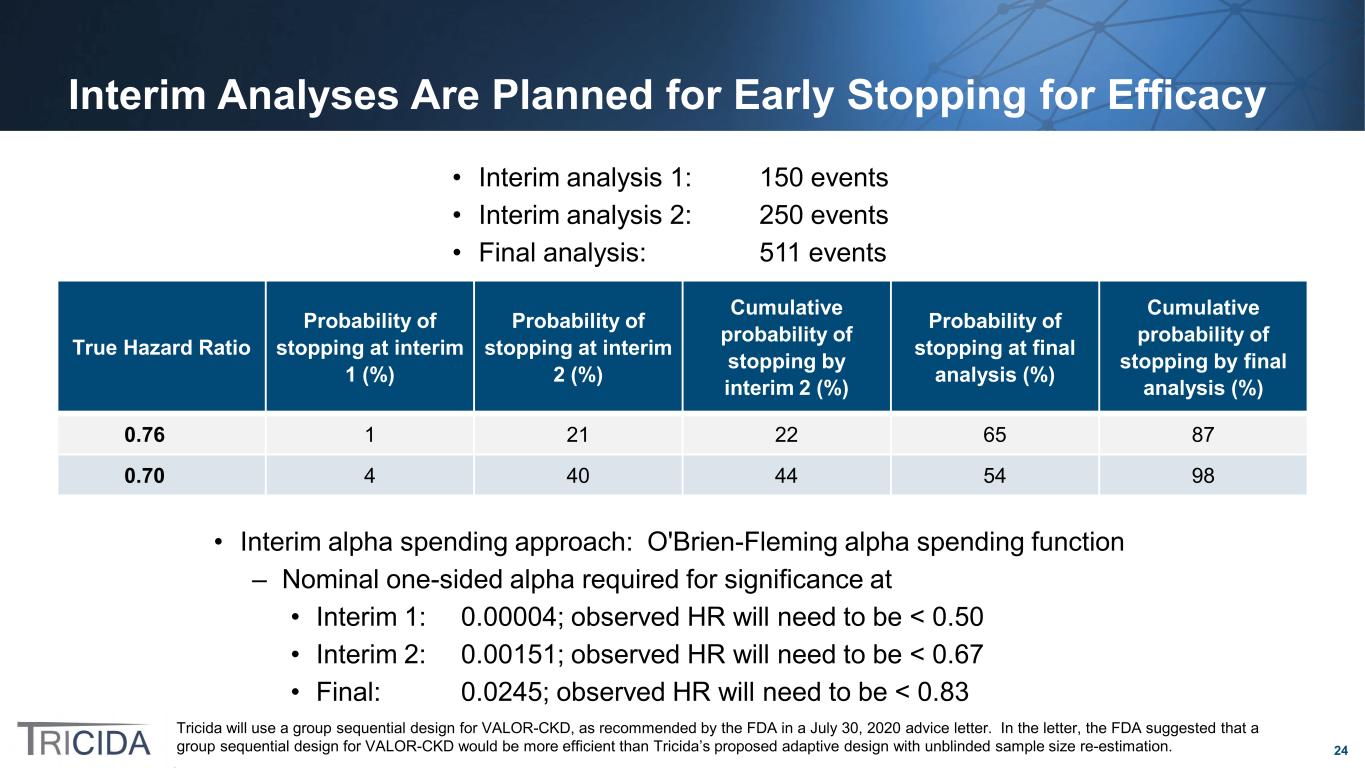
24 Interim Analyses Are Planned for Early Stopping for Efficacy • Interim alpha spending approach: O'Brien-Fleming alpha spending function – Nominal one-sided alpha required for significance at • Interim 1: 0.00004; observed HR will need to be < 0.50 • Interim 2: 0.00151; observed HR will need to be < 0.67 • Final: 0.0245; observed HR will need to be < 0.83 True Hazard Ratio Probability of stopping at interim 1 (%) Probability of stopping at interim 2 (%) Cumulative probability of stopping by interim 2 (%) Probability of stopping at final analysis (%) Cumulative probability of stopping by final analysis (%) 0.76 1 21 22 65 87 0.70 4 40 44 54 98 • Interim analysis 1: 150 events • Interim analysis 2: 250 events • Final analysis: 511 events Tricida will use a group sequential design for VALOR-CKD, as recommended by the FDA in a July 30, 2020 advice letter. In the letter, the FDA suggested that a group sequential design for VALOR-CKD would be more efficient than Tricida’s proposed adaptive design with unblinded sample size re-estimation.

25 Alternative Strategy to Stop VALOR-CKD Trial Prior to the End of 2022 for Administrative Reasons True Hazard Ratio Administrative Stop at 150 Events Administrative Stop at 250 Events 0.76 39% Power 58% Power 0.70 59% Power 81% Power Observed Hazard Ratio Needed for Significance 0.72 Hazard Ratio 0.78 Hazard Ratio * Assumes no interim analyses have been conducted prior to stopping the trial for administrative reasons Powering Assumptions and Observed Hazard Ratios for Stopping the VALOR-CKD Trial for Administrative Reasons*
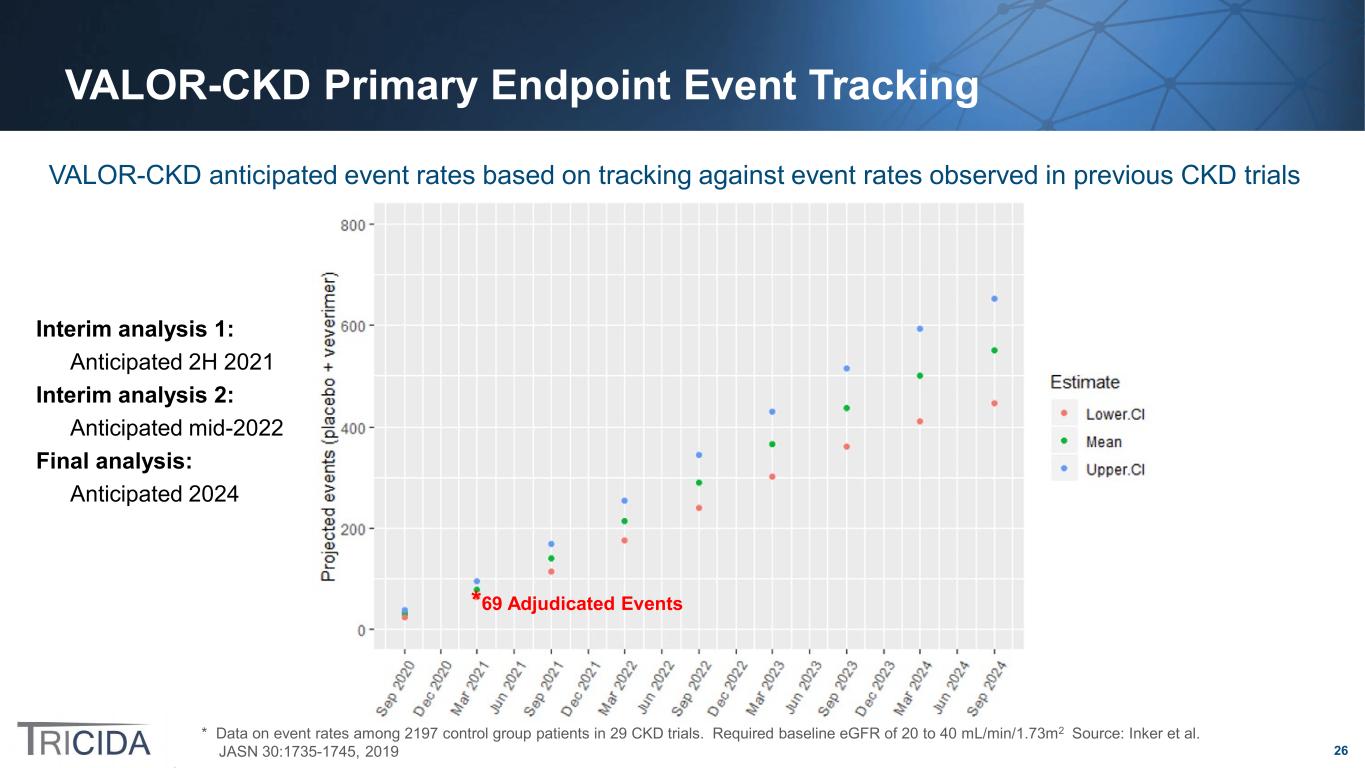
26 VALOR-CKD Primary Endpoint Event Tracking Interim analysis 1: Anticipated 2H 2021 Interim analysis 2: Anticipated mid-2022 Final analysis: Anticipated 2024 VALOR-CKD anticipated event rates based on tracking against event rates observed in previous CKD trials * Data on event rates among 2197 control group patients in 29 CKD trials. Required baseline eGFR of 20 to 40 mL/min/1.73m2 Source: Inker et al. JASN 30:1735-1745, 2019 *69 Adjudicated Events
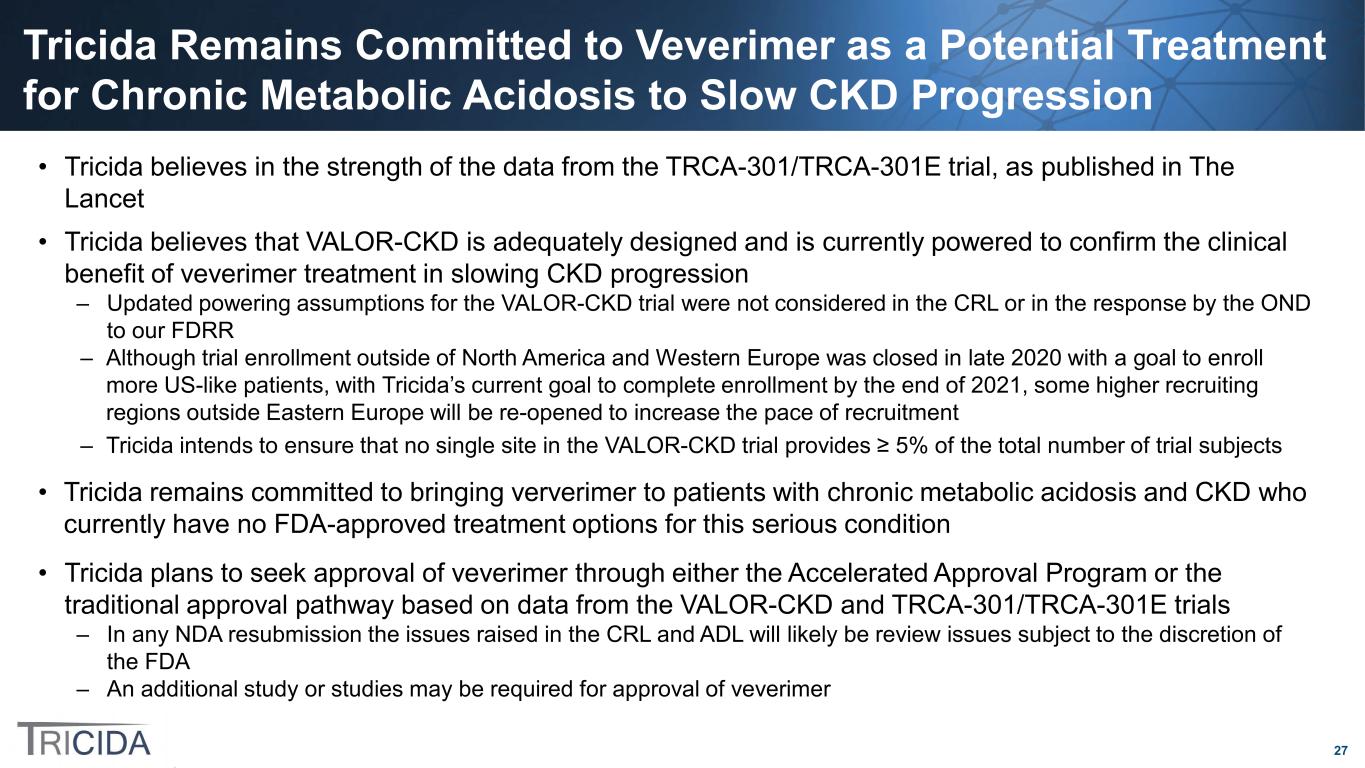
27 • Tricida believes in the strength of the data from the TRCA-301/TRCA-301E trial, as published in The Lancet • Tricida believes that VALOR-CKD is adequately designed and is currently powered to confirm the clinical benefit of veverimer treatment in slowing CKD progression – Updated powering assumptions for the VALOR-CKD trial were not considered in the CRL or in the response by the OND to our FDRR – Although trial enrollment outside of North America and Western Europe was closed in late 2020 with a goal to enroll more US-like patients, with Tricida’s current goal to complete enrollment by the end of 2021, some higher recruiting regions outside Eastern Europe will be re-opened to increase the pace of recruitment – Tricida intends to ensure that no single site in the VALOR-CKD trial provides ≥ 5% of the total number of trial subjects • Tricida remains committed to bringing ververimer to patients with chronic metabolic acidosis and CKD who currently have no FDA-approved treatment options for this serious condition • Tricida plans to seek approval of veverimer through either the Accelerated Approval Program or the traditional approval pathway based on data from the VALOR-CKD and TRCA-301/TRCA-301E trials – In any NDA resubmission the issues raised in the CRL and ADL will likely be review issues subject to the discretion of the FDA – An additional study or studies may be required for approval of veverimer Tricida Remains Committed to Veverimer as a Potential Treatment for Chronic Metabolic Acidosis to Slow CKD Progression
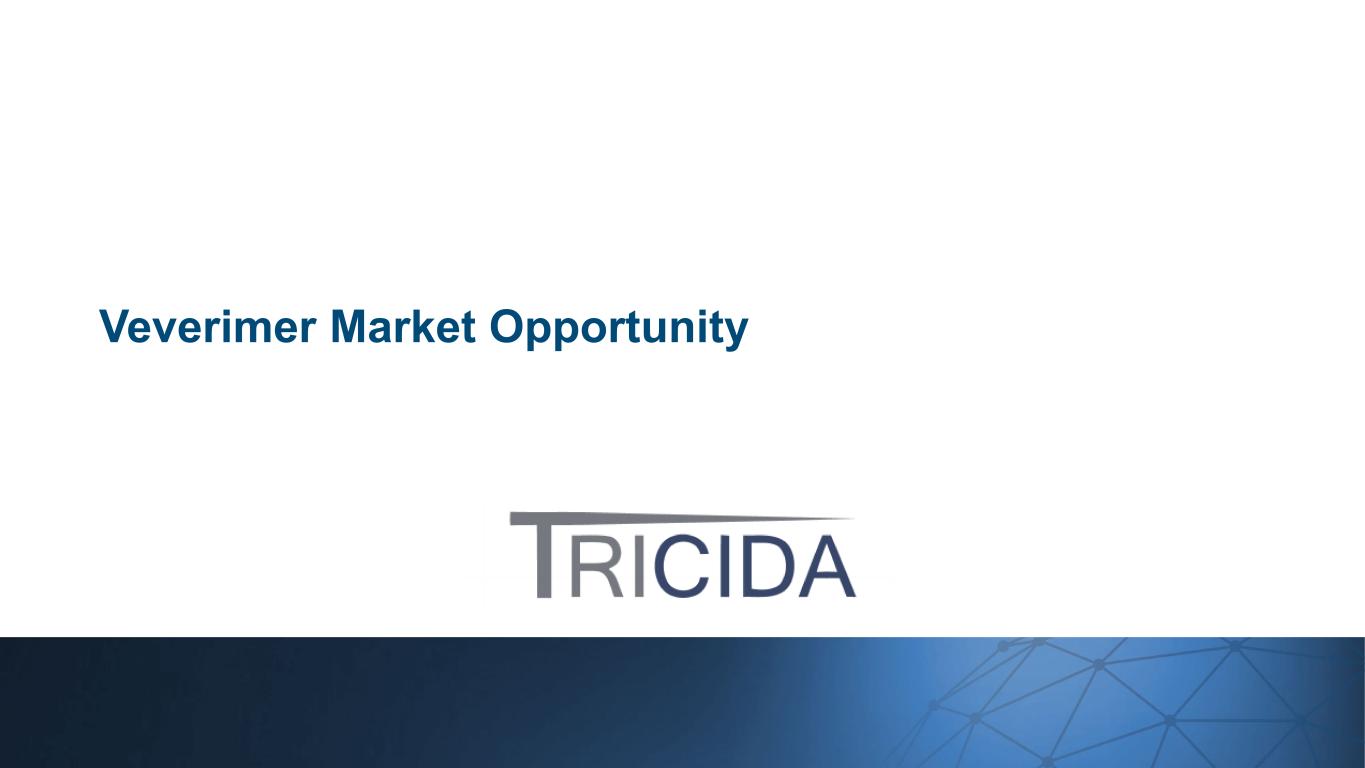
Veverimer Market Opportunity
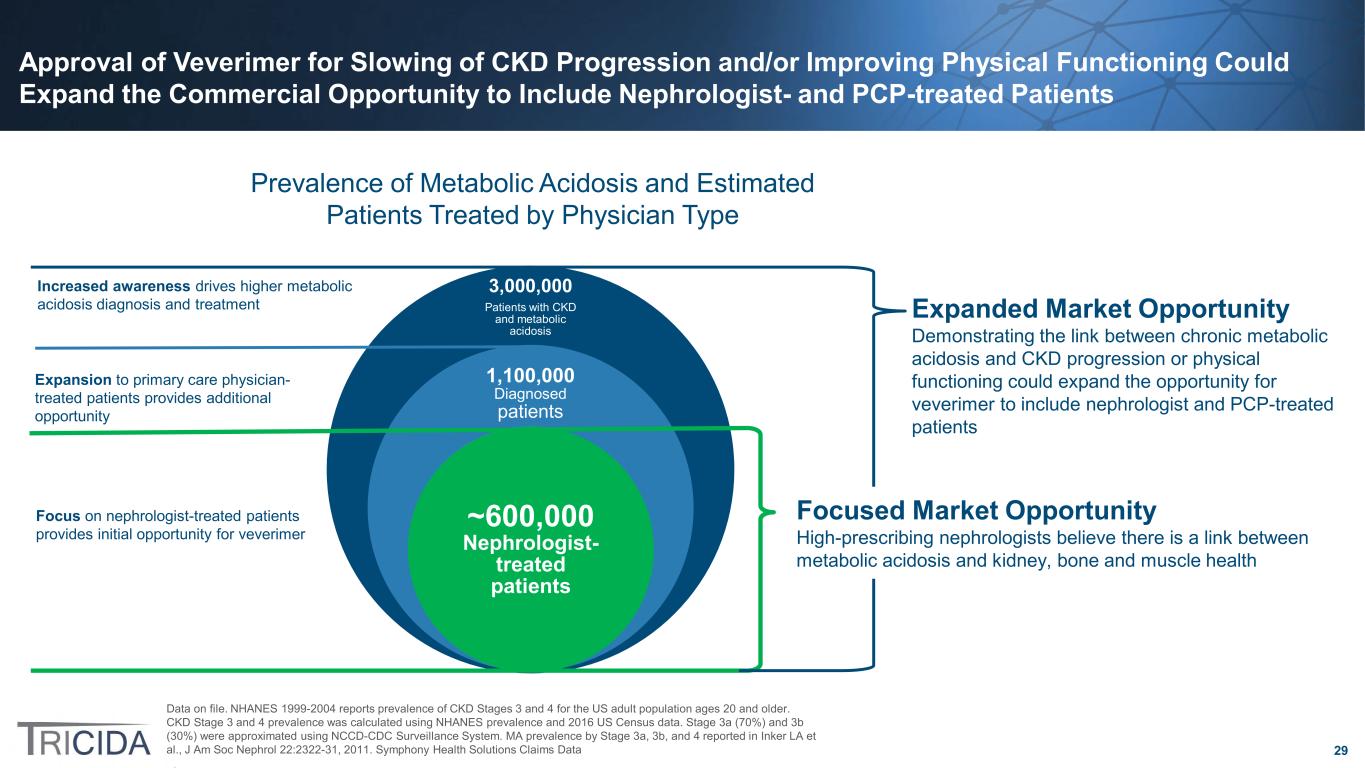
29 3,000,000 Patients with CKD and metabolic acidosis 1,100,000 Diagnosed patients ~600,000 Nephrologist- treated patients Approval of Veverimer for Slowing of CKD Progression and/or Improving Physical Functioning Could Expand the Commercial Opportunity to Include Nephrologist- and PCP-treated Patients Focus on nephrologist-treated patients provides initial opportunity for veverimer Expansion to primary care physician- treated patients provides additional opportunity Increased awareness drives higher metabolic acidosis diagnosis and treatment Prevalence of Metabolic Acidosis and Estimated Patients Treated by Physician Type Data on file. NHANES 1999-2004 reports prevalence of CKD Stages 3 and 4 for the US adult population ages 20 and older. CKD Stage 3 and 4 prevalence was calculated using NHANES prevalence and 2016 US Census data. Stage 3a (70%) and 3b (30%) were approximated using NCCD-CDC Surveillance System. MA prevalence by Stage 3a, 3b, and 4 reported in Inker LA et al., J Am Soc Nephrol 22:2322-31, 2011. Symphony Health Solutions Claims Data Expanded Market Opportunity Demonstrating the link between chronic metabolic acidosis and CKD progression or physical functioning could expand the opportunity for veverimer to include nephrologist and PCP-treated patients Focused Market Opportunity High-prescribing nephrologists believe there is a link between metabolic acidosis and kidney, bone and muscle health

30 Analysis of Major Payer Database Shows Metabolic Acidosis Increases the Cost of Health Care Metabolic Acidosis Has a Significant Impact on Health Care Costs Optum® EMR, De-identified electronic medical records 2007–2017. Reaven N, Association of Managed Care Pharmacy; Oct 31, 2019 and ASN Kidney Week Nov 7, 2019 ~$40K of added costs/year CKD stage 3 to 5 non-dialysis patients with metabolic acidosis costs ~$40K more than CKD patients with normal serum bicarbonate Impact of metabolic acidosis comparing all-cause cost in an acidotic vs. non-acidotic population Each 1 mEq/L increase in serum bicarbonate was associated with a 7% decrease in all cause monthly healthcare costs (p<0.0001) Impact of increase in serum bicarbonate as a continuous variable in combined acidotic and non-acidotic population

Intellectual Property, Financial Position and Upcoming Milestones

32 • Seven issued Orange Book eligible patents provide patent protection until 2038 • Several pending patent applications United States • Three issued EPO patents providing patent protection until 2034 and two additional issued patents providing protection until 2035 • Several pending EPO patent applications Europe Rest of World • Issued patents provide protection in numerous countries/regions outside the US and Europe* • Corresponding pending patent applications in other commercially significant countries New Veverimer Composition of Matter Patent Extends Patent Coverage to 2038 in the United States Patent term does not include any extension related to Hatch-Waxman in the United States, or a Supplementary Protection Certificate in Europe. Veverimer is an in-house discovered, new chemical entity. * Patent protection expected to provide protection for veverimer until at least 2034 in Australia, China, Hong Kong, Israel, Japan, Mexico and certain other markets. New Orange Book eligible patent, issued March 2021, extends patent protection to 2038
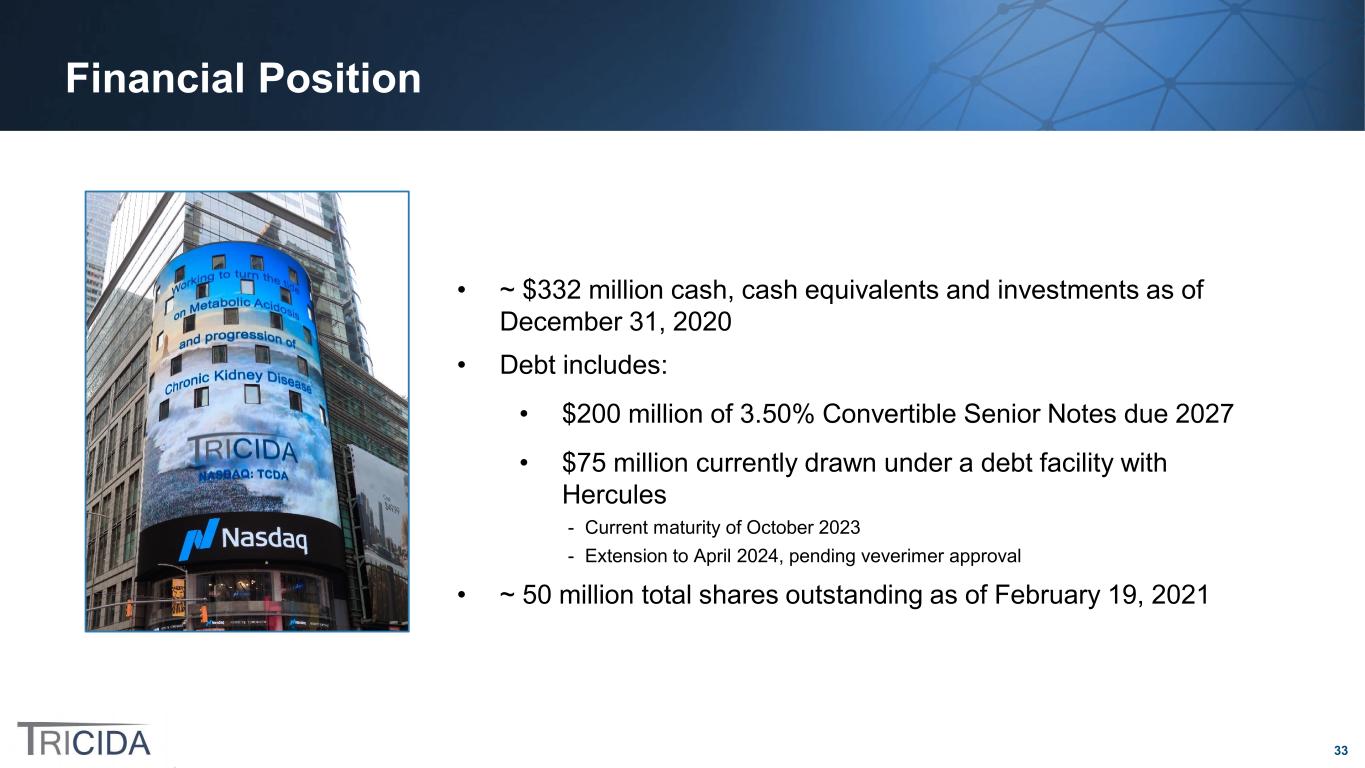
33 Financial Position • ~ $332 million cash, cash equivalents and investments as of December 31, 2020 • Debt includes: • $200 million of 3.50% Convertible Senior Notes due 2027 • $75 million currently drawn under a debt facility with Hercules - Current maturity of October 2023 - Extension to April 2024, pending veverimer approval • ~ 50 million total shares outstanding as of February 19, 2021

34*Veverimer is not yet approved by the FDA Key Veverimer Milestones* Obtained clarity on the path forward for resubmitting the veverimer NDA through the Accelerated Approval Program Conduct interim analysis 1 for potential early stopping of VALOR-CKD for efficacy Anticipated completion of VALOR-CKD trial without early stopping for efficacy or administrative reasons Conduct interim analysis 2 for potential early stopping of VALOR-CKD for efficacy 1Q’21 ~3Q’21 ~2Q’22 ~1Q’24 Potential Early Stopping of VALOR-CKD for administrative reasons In 2022
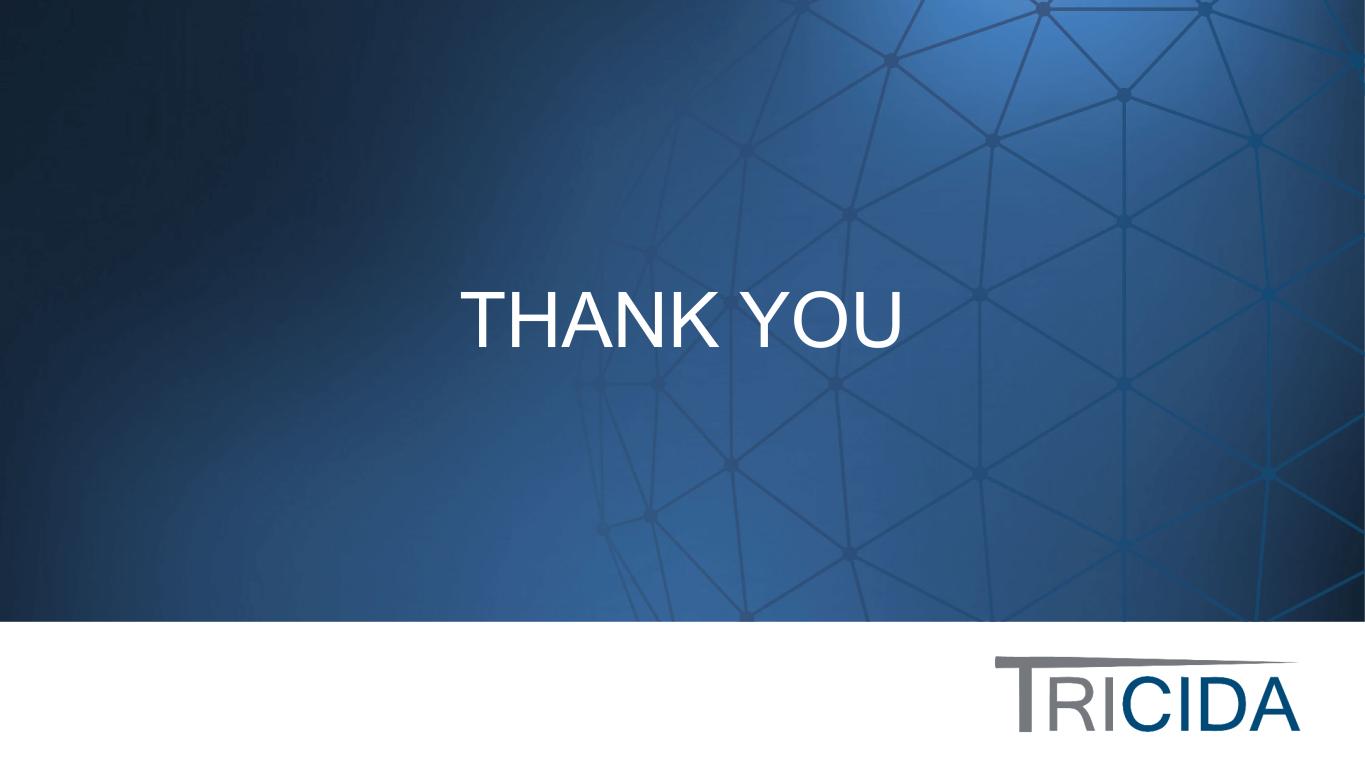
THANK YOU


































